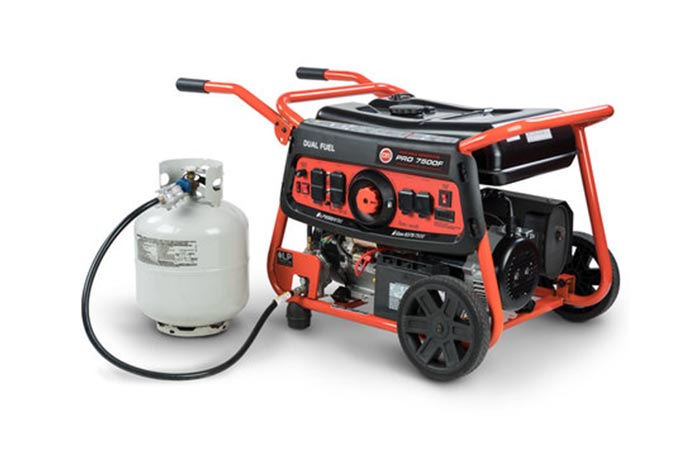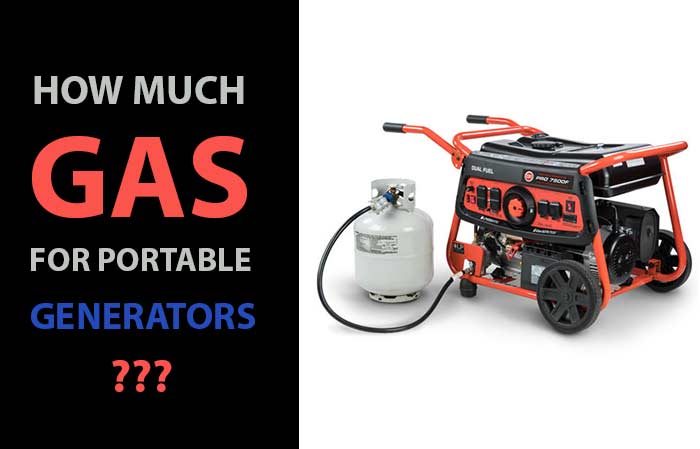One of the main factors to consider when buying a generator is the fuel efficiency. This refers to the amount of fuel you’ll need per unit time. While there are many factors that determine how much fuel you will need to run the generator for a specific amount of time, the measurement unit has always been the time the generator can run per gallon of fuel at a specific load level.
For most generators, this load level is either 25%, 50% or 100% with the fuel efficiency being based on the runtime per tank of fuel. With fuel tanks for different generators differing wildly in size, the standard way to compare the fuel efficiency of generators is the runtime at a similar load level.
In this guide, we look at the amount of fuel generators use, the factors determining these amounts, and the common fuel consumption levels of a lot of common generators. While the focus is on getting the most fuel-efficient generator for yourself, other factors such as the noise level, cost and size of the generator might make you reconsider that.
Amount of fuel used
The amount of fuel used by a generator is highly subjective since it depends on many different aspects. The most important determinant is the amount of load the generator is shouldering. Basically, the higher the load, the higher the amount of fuel used.

The other major issue is the type of fuel used with gas being used the least and propane the most for the same amount of load. Further details are provided in the sections below.
Factors that will determine the amount
The aspects that dictate how much fuel you’ll be using with your generator include the following:
Amount of load
The load refers to the amount of power being drawn from the generator and is measured in Watts (or horsepower). It’s easy to measure as you simply read the starting and running wattages of the electric appliance.
If you’re running more than one appliance, simply add up the wattages of each appliance to find the total load on the generator.
The load on a generator is rated in fractions or percentages to denote how much of the total output is being used. As such, ½ load is 50% of the total output from the generator. Generally, the higher the load, the more the fuel used up by the generator.
A lot of the consumption levels (gallons per hour) are rated at either 25%, 50% or 100% power use.
Fuel type
The main types of fuel for generators are diesel, gasoline, propane and natural gas. They differ in cost, convenience, the power provided and the consumption rate. The fuel types and their respective traits include as follows:
Gasoline
Gasoline is the most convenient fuel as it’s easily available in almost all places. Besides that, it’s also the most cost-effective when it comes to the consumption amount as it runs about 0.75 gallons per hour. It provides reliable power on average.
Propane
Of the three types of fuel, propane is the cleanest of them. It costs about as much as gasoline but has a higher consumption rate at an average of 3.44 gallons per hour. Some generators can use both propane and gasoline as per the user’s needs and the available fuel.
Diesel
Diesel is the heaviest and most powerful of the three fuel types. For his reason, it’s used for the bigger generators supplying large amounts of power. On average, a generator uses 2.9 gallons of diesel per hour. In terms of costs, diesel costs more than gas and propane per gallon.
Natural gas
Although not mainstream, there is a good number of generators that rely on natural gas as a fuel. The fact that most homes are already equipped with natural gas supplies makes them very convenient for any home.
In terms of consumption, a 20-kilowatt generator would use approximately 289ft3 per hour while a 30-kilowatt generator will use approximately 416ft3 per hour. This is the rate at full load (100%).
Generator brand and type
The brand of the generator also determines the fuel consumption as different manufacturers use different levels of fuel efficiency. The good news is that each manufacturer aims at providing the most efficient generator possible. Usually, there is a tradeoff such as weight, noise levels and other aspects.
Environmental factors
The main environmental factors affecting generators are the altitude, temperature and humidity levels.
Temperature
High temperatures lead to a lower air density. As such, there is little air being supplied to the combustion chamber for combustion. The engine of the generator will thus strain and use up more fuel than necessary to match the power output required.
Altitude
At high altitude, the air density is low and will have the same effect as when the ambient temperatures are high. Also, the thin air doesn’t cool the generator fast enough leading to increased temperatures on the generator. The result is more fuel being used than usual.
Humidity
High amounts of water in the air in humid areas displace oxygen leading to less of it being available for combustion. The result is higher fuel levels being used up to provide the same amount of energy as in averagely-humid regions.
These factors help you determine the most ideal conditions for your generator.
Popular Generators and Their Fuel Consumption
| Fuel Consumption | Weight (pounds) | Noise Levels (Decibels) | |
| Yamaha | 10.5 hours at ¼ load | 44 | 51.5 at ¼ load |
| Generac | 7.7 hours at ¼ load | 46 | |
| Honda | 8.1 hours at ¼ load | 47 | 53 at ¼ load |
| WEN | 6 hours at ½ load | 48 | 51 at ¼ load |
Energy-Saving Tips
No matter the type of generator you have, some energy-saving tips will help you save on the fuel costs. They include the following:
- When using your generator, use the stovetop and not the water heater to heat water. This is because the stovetop uses less energy to heat the same amount of water compared to the water heater.
- Use energy-hungry appliances for a limited time and shut them off as soon as you’re done.
- If your fridge has a motor, convert it to a low voltage compressor as the latter uses less energy. In general, motor equipment use more energy than non-motor ones.
- Use energy saving appliances such as bulbs and others.
These and many other tips help you save money.
